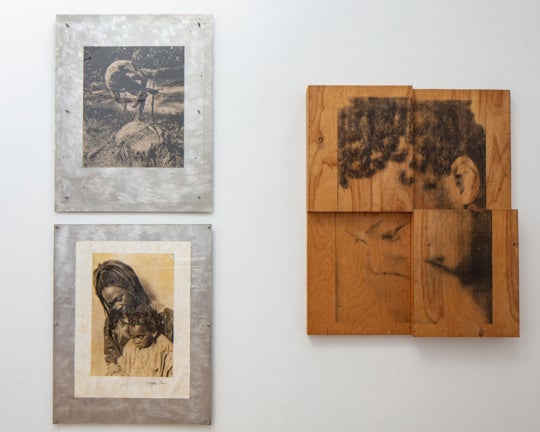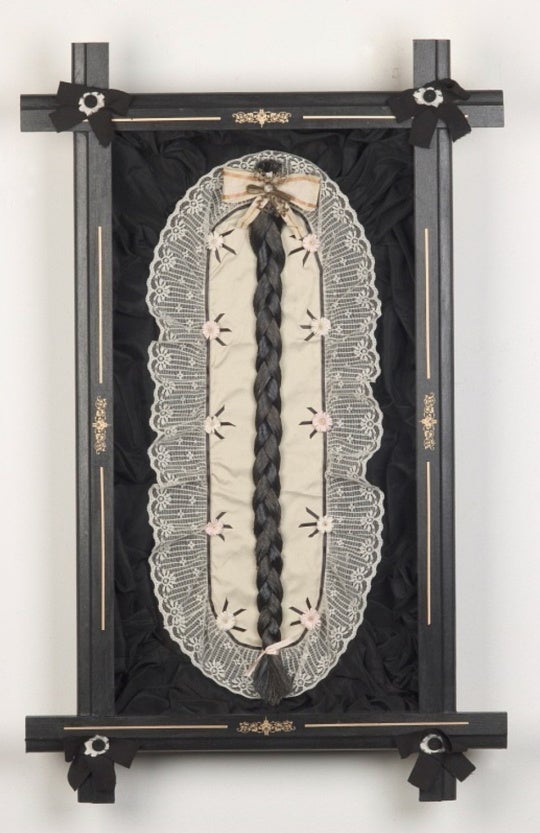
Mickalene Thomas is well-known for her embellished paintings — glitter, rhinestones, floral patterns, bright colors, wood grain, nude and lavishly dressed bodies, animal prints galore — in all their tactile and dazzling glory. They’re lively, playful and sensuous; they’re bold and assertive. The spirit of the works extends beyond their surfaces. And that goes for the worlds within the paintings as well the world beyond them, because the same nostalgic indulgence present in her paintings also radiates from her photographs. The exhibition “Muse: Mickalene Thomas Photographs and tête-à-tête,” on view at the Georgia Museum of Art in Athens through January 7, presents dozens of works by Thomas and several of her creative muses in which ostentatious subjects and environments manage to feel comforting and even familiar at times.
That sense of comfort is, perhaps, to be expected, because the show is about the people Thomas holds dear — family, artists, and lovers. It features a busy, print-covered set like the one she creates for her photographs, with her documentary ode to her late mother, Happy Birthday to a Beautiful Woman, playing on an old TV set in the center. Given Thomas’s work so frequently depicts domestic interiors and people she knows, it makes sense that the exhibition exudes the conviction and self-assurance that comes from being at home, physically and metaphorically.

But the way in which Thomas cultivates that feeling of confidence isn’t so obvious. Subtleties of gesture, expression, props, and even arrangement of the physical gallery spaces combine to tell an intricate story about how Thomas’s influences molded her into the artist she is today — one who questions the authority of existing stereotypes and exposes the complex cogs of identity and perception.
Take La Leçon d’amour (The Love Lesson), one of the first photographs displayed in the exhibition. A woman, sprawled dramatically across another woman’s lap, is decked out in a royal blue shirt, golden braided belt, and strappy heels, her legs exposed and lustrous. The other woman, whose neatly shaped cotton-white afro forms a perfect halo, stares at the reclined woman lovingly and touches her delicately.
The composition at first suggests a pietà — in which the Virgin Mary holds Jesus’s limp body after his crucifixion — in brash colors and ’70s garb, but then signs of struggle and complexity reveal themselves: a bouquet of plastic flowers lie on the ground near the reclining woman’s hand as if she’d let them go purposefully, and a sticker on the bottom of her well-worn shoe betrays the manufactured perfection of the scene. Through these small but disruptive details, the innocence and sacredness that initially appeared to define the women’s relationship is subverted, suggesting a backstory that is not as immaculate as it seems. (The soundtrack album to the rebellious and recontextualized Jesus Christ Superstar is even tucked in a corner of the room, quietly reflecting a subtext of conflict and alternate narratives.)

Many of the works in the exhibition are vibrant, even bordering on garish, and emphasize the dramatic nature of the staged photos. But one room is more brightly lit than the others and sparsely installed with a few portraits of a woman, as if they need room to breathe. In Sandra: She’s a Beauty, Thomas’s mother, Sandra Bush, stares knowingly at the viewer, proud, poised, and adorned with bold jewelry. In Negress, Thomas portrays her alter ego Quanikah, her legs splayed and arm hanging off her chair nonchalantly, apparently unfazed by the presence of the camera. These characters and their gazes create the sense of an intimate conversation that visitors are interrupting. Even the dark brown rectangle on the light wood floor of the gallery suggests an invisible table, bringing to mind the significance of the dinner table throughout art and literature as a place for camaraderie, conversation, domesticity, gathering and unity.
That conversation continues in “tête-à-tête,” a segment of the exhibition Thomas curated that contains the work of a rotating cast of her inspirations, including Hank Willis Thomas, Lyle Ashton Harris, Malick Sidibé, and Carrie Mae Weems. It is often noted that Thomas’s work reimagines the presentation of the black female body, challenging the hypersexualization and objectification it’s been subjected to throughout history, so that the female subject possesses the formidable gaze instead of being the passive object of the male viewer’s.

But more than that, she pays careful attention to the politics of the body, movement and expression, specifically in relation to race — and that propensity is evident in the works she curated for “tête-à-tête.” The positioning of arms and use of touch as a means of emotional exchange is prominent. Two black men shake hands and touch shoulders affirmatively in Derrick Adams’s Crossroads; in Xaviera Simmons’s Composition One for Score A, a confident figure in a structured black dress points to a vast, largely monotonous landscape, her elegant attire incongruous with the desolate environment. Performance for performance’s sake, performance as identity, and performance for survival are motifs in the exhibition and Thomas’s work. The photograph-and-paper collages included in the exhibition help highlight this thin line between reality and manipulation of reality.
The first and last photos in the exhibition are perfect bookends. “Qusuquzah, Une Trés Belle Négresse #1” greets visitors stoically in an orange top with a deep neckline and contrasting blue hat. And “Din, une très belle négresse #1” dares us to stare back before leaving the exhibition space. These women declare their presence, have stories to tell, and command our respect.
Yves Jeffcoat is an Atlanta-based writer.




